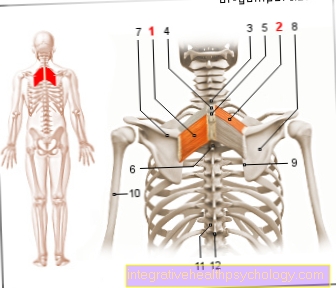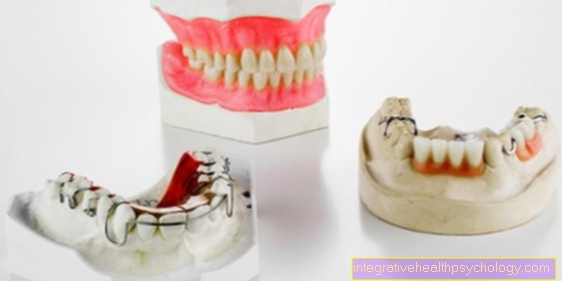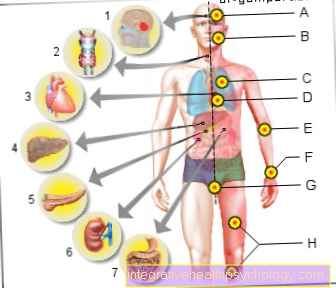The diagnosis of bronchial asthma
introduction
Bronchial asthma is a chronic inflammatory disease of the lungs. In bronchial asthma, the airways are reversibly narrowed and hypersensitive.
The symptoms can differ depending on the severity of the disease. You may have to clear your throat, cough or become short of breath. The more common these symptoms appear, the more serious the condition is. Various lung function tests are available to make a final diagnosis.

The classification of bronchial asthma
According to the cause:
- allergic or extrinsic asthma
- non-allergic or intrinsic asthma
- Mixed forms
According to the guidelines of the German Airway League, the symptoms can be divided into the following degrees of severity of brocnhial asthma:
- Bronchial asthma degree: Intermittent (with interruptions)
Symptoms of asthma occur fewer than twice a week during the day and fewer than twice a month at night. In addition, the FEV (explanation see diagnosis) is over 80%. - Bronchial asthma degree: Persistent (permanent), mild
On average, symptoms occur less than once a day, which means that there are also days off within a week when you are symptom-free. The number of symptomatic nights increases to more than twice a month. In addition, the FEV is still over 80% here. - Bronchial asthma grade: Persistent medium
Symptoms appear daily, once a week at night. The FEV is between 60% and 80%. - Bronchial asthma grade: Persistent severe
Symptoms are constant during the day, more often than once a week at night, and the FEV is below 60%.
More information about the Causes of asthma you'll find here.
The diagnosis
A distinction is made here between the diagnosis of an acute asthma attack and the asthma diagnosis during the symptom-free interval. The acute asthma attack can be determined based on the characteristic symptoms as described above (exhalation difficulty, exhalation noises, coughing, exhaustion).
If the asthma symptoms described occur, the doctor should be consulted even if the symptoms appear to be free. The diagnosis of asthma usually results from the description of the typical symptoms. The symptom cough is less meaningful than e.g. the appearance of whistling noises (stridor or wheezing).
The lung function test plays an important role in the diagnosis of asthma. It consists of several tests, all of which are designed to determine whether the lungs are not functioning properly or are working normally.
The spirometry
Spirometry is important for assessing lung function. For the examination, the patient breathes through the mouth into the mouthpiece of a spirometer, the nose is closed with a nose clip. The device measures how much force is inhaled and exhaled and what amounts of air are moved. The device then graphically depicts the air volumes as a curve. In addition to normal breathing, the device is also used to test how the values change with maximum inhalation and exhalation.
One of the most important values for diagnosing bronchial asthma is the one-second capacity, also known as FEV1 (forced expiratory (exhaled) volume in 1 second) or Tiffeneau test. During this procedure, the patient is asked to inhale as deeply as possible and then exhale as quickly and deeply as possible. The spirometer then shows how much volume of the inhaled air has been exhaled within the first second.
This value is lower in bronchial asthma because the air has to overcome a greater resistance due to the chronic inflammation and narrowing of the airways (see figure below). Even if you do not notice this greater resistance in the symptom-free interval, it can be measured using the spirometer.
Find out all about the topic here: The pulmonary function test.
The “peak flow” measurement
The peak flow measurement is particularly suitable for diagnosing the severity of an asthma attack. The devices are very handy and can e.g. used by an asthmatic at home for self-monitoring, which is why it is also known as the “asthmatic's clinical thermometer”.
To measure the "peak flow" one also breathes through a mouthpiece, but here the peak flow, i.e. the strongest air flow expelled from the lungs, is measured. It is not about the volume that is moved, but about the force with which the air flow escapes the mouth. If, as is typical with asthmatics, a resistance in the bronchi has to be overcome beforehand, the strength of the air flow is reduced. So falling values mean worsening asthma.
The provocation test
The metacholine provocation test is an inhalation provocation test. This means that the substance metacholine is inhaled by the patient. The response of the respiratory tract to the methacholine is then assessed.
Metacholine is a drug that stimulates the parasympathetic, i.e. the vegetative nervous system. In the case of existing asthma, the airways narrow even more than in healthy people, and shortness of breath can result.
The test is assessed using spirometry. The patient to be examined is given the metacholine through a nebulizer. Then you measure values such as the one-second capacity or the airway resistance. If these have exceeded a certain value, they are pathological. The suspicion of hypersensitivity of the airways can thus be secured.
Also read the article: The pulmonary function test.
The allergy test
In addition to the lung function, an allergy test should also be carried out in allergic bronchial asthma, e.g. using a prick test. In the prick test, various liquids that contain an allergen (e.g. cat hair, birch pollen or rye flour) are applied to the forearm. A point is used to gently pierce the skin covered by the solution.After a while, red swellings will form if there is an allergy to the allergen applied.
In addition to the allergy test, total IgE can be determined. A significant increase in total IgE is an important indicator of the presence of an allergic disease. You can also search specifically for the IgE antibodies that are directed against the suspicious allergen.
Further information on this topic can be found at: The allergy diagnostics.
The imaging
An X-ray of the chest (chest) can be normal in the early stages of the disease, but serves to rule out other diseases that may cause symptoms similar to asthma in the acute phase of the disease.
If the disease has persisted for a long time, conclusions can be drawn from the x-ray image about possible tissue damage to the lungs.
Which doctor diagnoses asthma?
If bronchial asthma is suspected, you should be referred to a pulmonologist (pulmonologist). He is familiar with the various diagnostic methods (spirometry, peak flow) and can reliably assess the values.
During the examination, the pulmonologist will ask you a few questions in order to record your medical history. This is followed by a physical exam that includes auscultation of the lungs. Here you try to hear pathological breathing noises, such as wheezing. Depending on the findings, various pulmonary function tests are arranged. In some cases, imaging (chest x-ray) may also be necessary.
What diagnostic criteria are there?
There are various criteria to confirm the diagnosis of bronchial asthma. These would be: the clinical symptoms, the anamnesis (recording of the medical history), the evidence of a narrowing of the airways and the reversibility of this condition.
The clinical symptoms express themselves in a throat clearing, coughing, pathological breathing noises and in acute cases in a shortness of breath. The attending physician asks you specific questions (anamnesis) during the first examination and thus decides whether asthma could be an accurate diagnosis. A narrowing of the airways is proven by the specific lung function tests (spirometry, metacholine provocation test). The reversibility of this condition is checked by specific drugs - so-called beta symphatomimetics. These drugs cause the airways to widen and the patient can breathe freely again.
If all these criteria are met, the diagnosis of bronchial asthma is confirmed.
This article might also interest you: The therapy of asthma.





























